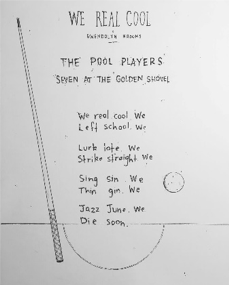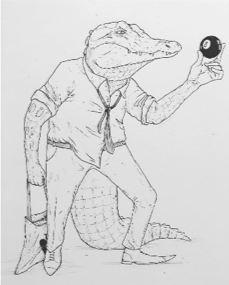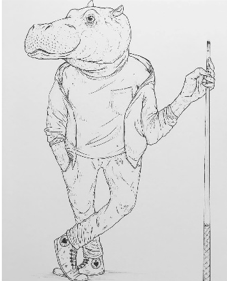Talking to Houl by Aries Matheus
- rpardoUWB
- Apr 27, 2019
- 6 min read
Updated: Aug 1, 2019
James Houl rarely speaks about his own art even though he spends most week days talking about other artistic works as an English teacher—until now. On Friday, February 22 during an artists’ talk at The Commons in Annapolis, sponsored by Urban Walls Brazil, James spoke to an audience of fellow artists and art lovers about his current projects, his views on art, and the juxtaposition of artistic styles he witnessed when he moved from Australia to Annapolis under a year ago. While James covered a range of topics and answered questions from engaged audience members, the main focus of the talk was the collection of illustrations of birds drawn on cigarette packs he found discarded on his morning stroll to work.
“I chose this particular medium because as I walked around Annapolis exploring the city, I found crushed packets everywhere and, being a bit of a hoarder, I thought I can paint on this,” James said of the collection, he affectionately calls Ciggie Pack Birds.
“Annapolis, even America as a whole, has such different wildlife from Australia– we don’t have squirrels back home, we don’t have vultures or the same types of beetles,” James said. This love of birds and the new species found in Annapolis spurred James to create the series.
"When I started out I really wanted to look at critically endangered or extinct birds, but the ones that I’ve found more enjoyable to paint, are just the weirder looking birds and all these birds that you’ve never really hear about,” James said. “You get the parrots, these kinds of straight forward ones that everybody knows, but looking at an Edward’s pheasant, which I never heard of it before researching all these different animals, is a fun thing to do.”
The series of cigarette pack illustrations were accompanied by another set of James’ illustrations inspired by Gwendolyn Brooks’ poem “We Real Cool,” which James was teaching his students in class. The poem, published in 1960, was acclaimed due to its unique use of line breaks, also called enjambment; distinct rhythm; and ambiguity prompting questions such as who are “we”?
Besides facilitating James’ art talk, James believes Urban Walls Brazil provides an essential and rare service to Annapolis.
“Any entity that is actively pushing art is hugely important to a community because it’s making sure that Annapolis art doesn’t exist in a bubble so the cultural exchange component of Urban Walls is especially important,” James said. “It’s so important to introduce new ideas and ways of thinking so that things don’t stagnate and ideas don’t become inbred.”
James is also grateful to Urban Walls Brazil for the connections this art talk built.
“The talk introduced me to people I’m not familiar with and who aren’t familiar with me and suddenly they know me and my work,” James said, calling this art talk his formal introduction to the city. “This talk connected me with Annapolis and the people here who love art which is important since I’m new to the community here.”

James considered this art talk as his formal introduction to the city, but you may be more familiar with his information introduction to the city which includes four permanent works, the fourth and most recent being a mural outside of The Commons, and many smaller, sporadic installations around the city.
The smaller installations spawned out of James’ unwillingness to be idle. Whenever he doesn’t have a wall to paint, James works on his own projects drawn from his other sources of inspiration such as mythology and literature to keep from being idle. This includes a series of illustrations on cardboard which he leaves around the city for others to find.
“Honestly if I’m not doing anything then that’s wasted time for me. I will get up for work and the first thing I’ll do is go to my desk and start drawing,” James said. “When I haven’t created or drawn something for a couple of days I get frustrated or I get mopey and really kind of withdrawn and I’m like what am I doing, I need to get something done and the minute I pick up a pen again or pick up a pencil I’m back where I need to be.”
For the more permanent artwork in Annapolis, James seriously considers how the subject, pallet, and medium of his murals will affect the historic nature of the city.
“I have to consider if the piece fits in to the surroundings. So for the pair of tanager birds I paintedwith Jahroo(Jeff Huntington) required research to see what kind of birds, what details made them unique and the specifications of painting in the area,” James said of the large, colorful painting on Evelyn’s restaurant in West Annapolis which embodies the necessary melding of Annapolis and Austrian street art. James worked with local street artist, Jeff Huntington, to combine their bold and saturated paint styles on a realistic portrait of the tropical tanager sitting on a bowl of fruit that balanced bright oranges and reds with earthy green and mellow yellow tones.
“This piece was a little more realistic than I’m use to and turned out really well, but I’d like to do something more my style and find someone that is open to that,” James said. “In the meantime, I’ll just keep working with what people want. If they’ve got a wall to offer me, I’m not going to come in and say it’s my wall now and I’m going to paint what I want so you’ve got to have a dialog between he artist and the person whose wall it is.”

To James, found art, including street art, is something special because “it’s the work that has the least amount of barriers between the artists and the audience.”
“In a gallery people know ‘I’m going to go to this gallery to see curated work displayed in a particular way with a little write-up,’ yet people don’t need to know who the artist is for a piece up on the street and half the time there’re not even going out of their way to see it,” James said. “It also means people can read into street art what they want because the artist’s own meaning is only a small facet of it.”
James often incorporates subjects from mythology and books that he is teaching or reading into his personal pieces to introduce audiences to new subjects or perhaps even re-introduce old subjects to people in a new way to start a conversation and facilitate.
“Art is a way for me to extend my passions, like teaching and literature and mythology and reading, with other people through a completely different art form,” James said. “Art is giving people a reason to do something they haven’t done before.”
To keep busy and join an existing conversation, James joined The Online Book Club created by Alexis Winter, where participants are challenged to create a mini monotone illustration of a favorite book each month. James enjoyed the creative exercise so much that after the initial 12 month challenge, he continued to create a new cover for each book he read.
“The Online Book Club gave me an opportunity to really consider, both as I’m reading and after, what I liked about the book what I thought those key really defining moments were—I don’t think there’s going to be any end to this art form,” James said of the challenge which started with him drawing a black and white cover for the classic Fahrenheit 451, a drawing which was so loved someone turned it into a tattoo.
Wherever the painting, no matter the subject or the medium, James, in true teacher form, always wants his art to introduce the audience to a new subject or a new way to view a familiar subject as a way to start a conversation.
“There’s always that little part of me that wants them to find something or learn something from it or take something away that they hadn’t before,” James said. “People should be able to access the work understand and appreciate it regardless of whether they know the content.”
This passion to start conversations and express himself through art, drove James to take the necessary risks to meet and learn from other artists, to put his work out into the public eye, and to trust that his passion for art and teaching in a respectful, yet bold manner.
“My advice is if you do a work and it doesn’t come out how you intended, nobody else knows what you envisioned that work looking like, they only see it as a completed project so to them is perfect and its everything that you wanted it to be. That’s why we can be our own harshest critic” James said. “When I realized that it was this massive movement for me because before I was like ‘oh, I overdrew this line’ or ‘this isn’t as wide as I wanted,’ but then I was like nobody else noticed what it was meant to be so it was a moment of growth for me.”
“So if somebody wants to try something new, the try something new,” James continued. “Give it a go if it doesn’t work out give it another go. If after 4-5 times you’re still struggling with it then go and find someone that does know what they’re doing, get them to give you a hand because that’s how you push on.”
James’ work, including clues on the whereabouts of the cardboard illustrations, are posted on James’ Instagram and his website.
Aries Matheos writes the “Around Annapolis” column, which appears Fridays in The Capital. She also writes for Capital Style magazine and wrote for Bay Weekly newspaper before graduating from the University of Maryland College Park with a bachelors degree in English. She currently works as a freelance writer and social media specialist.


































Comments